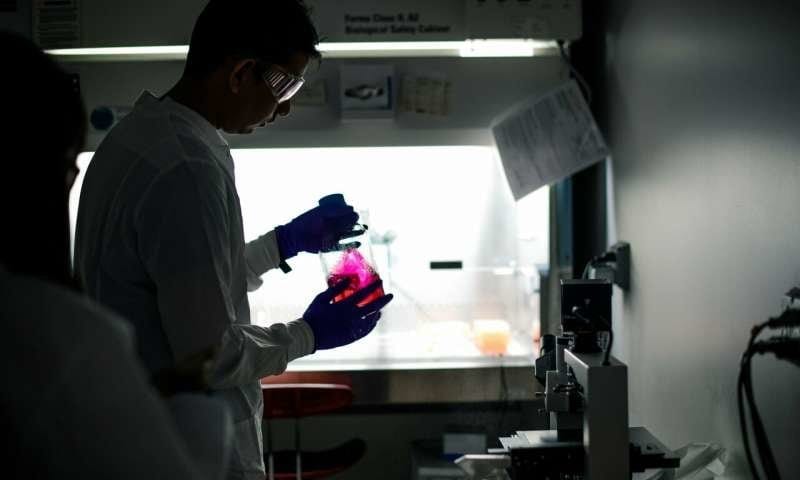
Patching up a heart needs the help of tiny blood vessels. Aligning dense vascular structures in engineered cardiac patches can help patients recover from a heart attack.
A team led by Feng Zhao, associate professor of biomedical engineering at Michigan Technological University, recently published two new papers on best practices in engineering prevascularized tissues.
The team’s research paper, published in Theranostics (DOI: 10.7150/thno.29552), focuses on developing a stem cell cardiac patch made with tissue engineered with tiny blood vessels to be like real heart muscle. Their review paper, published in Acta Biomaterialia(DOI: 10.1016/j.actbio.2019.03.016), examines the pros and cons of six innovative strategies for aligning the microvessels in engineered tissues.
Bioengineered Tissue, Organized Vasculature
The vascular system brings nutrients and oxygen to tissues; important ingredients for successful healing following an organ transplant, heart surgery or skin graft. Microvascular structures, which are capillary-like microvessels, are particularly important and, in order to be effective, must be highly aligned, dense and mature. Engineering biomaterials with such a robust vascular system is difficult and depends on the framework — the scaffold — to grow the cells.
“The significance of microvessel organization in 3D scaffolds has largely been ignored,” Zhao explained. “Microvessels are not the same as cells; people have done a lot of work looking at the alignment of cells but this work on microvessels is still new. Understanding the mechanisms behind microvessel alignment in biomaterials will help us and other biomedical engineers to create better, more refined implants and devices.”
To get there, Zhao and her team reviewed the advantages and disadvantages of six different methods used to align vessels: electromechanical stimulation, surface topography, micro-scaffolding and microfluidics, surface patterning and 3D printing.
The advantages vary quite a bit and focus on the ease or controllability of a method. Electromechanical stimulation is simply stretching; micro-scaffolding and microfluidics make medical testing easier; 3D printing is customizable. However, the disadvantages center on one major challenge: Engineered microvessels tend to be too big — they’re much larger than the real capillaries in heart tissues — and often they’re not dense and mature enough to properly supply nutrients and blood.
Aligning microvessels is a bit like plumbing, and mismatched sizes don’t bode well for turning the water on. For some hands-on problem solving, Zhao’s team focused in on biomimicking the microvessel alignment, density and dimension of heart muscle.
Vascularized Stem Cell Patch for Heart Health
To date, the engineering process to create the ideal biomaterial for a prevascularized cardiac patch has not made it to clinical trials. Zhao and her team hope to change that.
“Myocardial infarction is a big problem and currently there is no good treatment for it,” she said. A cardiac patch could help following a heart attack. “The cardiac patch is completely biological, comprised of stem cells with vasculature that mimics real tissue, that could help repair a heart.”
The Theranostics paper delves into the role of microvessels in that process and how an engineered tissue can follow the lead of natural ones. Lead author Zichen Qian, a doctoral graduate from Michigan Tech and now a research scientist at Merck, has worked extensively with Zhao on prevascularized tissues. The University recognized Zhao’s and Qian’s efforts last year with the Bhakta Rath Research Award. After Qian graduated, PhD candidates Dhavan Sharma and Wenkai Jia continued this research. The team says heart muscle is one of the trickiest tissues to work with.
“In the heart muscle, the cells are highly aligned for electromechanical signal transaction and the microvessels are also highly aligned and dense,” Zhao said, explaining that microvessels in the patch can connect to native vasculature, bringing nutrients and oxygen. Without this, the engineered cardiac patch might die. “But all tissues have this microstructure. It’s everywhere. This technology could be used for skeletal muscles, burn and chronic wound healingand nerve regeneration.”
Zhao and her team have shown the potential of biomimicry to grow microvessels in tissues suitable for a cardiac patch. The next steps will be animal trials and refining medical technology for implants and devices. With the help of tiny, dense, neatly aligned blood vessels, engineered tissues could help hearts, skin, bones and muscles regenerate naturally.
Learn and see more: Highly aligned structures is a key feature in engineered tissue. Credit: Feng Zhao
The Latest on: Engineering prevascularized tissues
[google_news title=”” keyword=”engineering prevascularized tissues” num_posts=”10″ blurb_length=”0″ show_thumb=”left”]
via Google News
The Latest on: Engineering prevascularized tissues
- Tissue engineering articles from across Nature Portfolioon April 25, 2024 at 5:00 pm
Tissue engineering is a set of methods that can replace or repair damaged or diseased tissues with natural, synthetic, or semisynthetic tissue mimics. These mimics can either be fully functional ...
- New experimental evidence unlocks a puzzle in vascular tissue engineeringon April 25, 2024 at 9:25 am
Angiogenesis is a process of forming hierarchical vascular networks in living tissues. Its complexity makes the controlled generation of blood vessels in laboratory conditions a highly challenging ...
- Will Heart Valve Tissue Engineering Change the World?on April 14, 2024 at 5:00 pm
Nat Clin Pract Cardiovasc Med. 2005;2(2):60-61. Several strategies for heart valve tissue engineering are evolving. They include the use of decellularized allogenic or xenogenic valve matrices ...
- Engineering professor advances deep tissue imaging with $2.5 million granton April 4, 2024 at 4:25 am
The grant, from the Chan Zuckerberg Initiative, was to advance a research project he is conducting with professors from Yale University and Cornell University to improve deep tissue imaging inside the ...
- Cardiovascular Reparative Medicine and Tissue Engineeringon February 20, 2024 at 2:49 pm
Cardiovascular Reparative Medicine and Tissue Engineering (CRMTE) aims to develop future technologies and therapeutic strategies that will serve as treatment for cardiovascular disease. CRMTE includes ...
- Department of Biomedical Engineeringon December 18, 2023 at 10:32 pm
Biocompatibility testing, engineering artificial organs and tissues, developing new drug delivery systems, creating or modifying innovative medical devices, enhancing medical imaging techniques, or ...
- Biomaterials and Tissue Engineeringon June 17, 2022 at 4:51 am
Nanoscale structure-property relationships of biological materials, genetic and molecular origins of soft joint tissue diseases, biomaterials under extreme conditions, coupling between ...
- Tissue engineeringon December 1, 2021 at 5:49 am
Tissue engineering is emerging as a significant potential alternative or complementary solution, whereby tissue and organ failure is addressed by implanting natural, synthetic, or semisynthetic ...
- tissue engineeringon July 6, 2016 at 5:00 pm
In a paper in Science, [Kevin Kit Parker] and his team at the fantastically named Wyss Institute for Biologically Inspired Engineering ... model organisms for a tissue engineered robot.
- Tissue Engineering and Biomaterialson February 11, 2016 at 1:03 am
The department’s tissue engineering and biomaterials research focuses on developing new materials for applications in medicine and biology, as well as engineering biological tissues from adult stem ...
via Bing News










